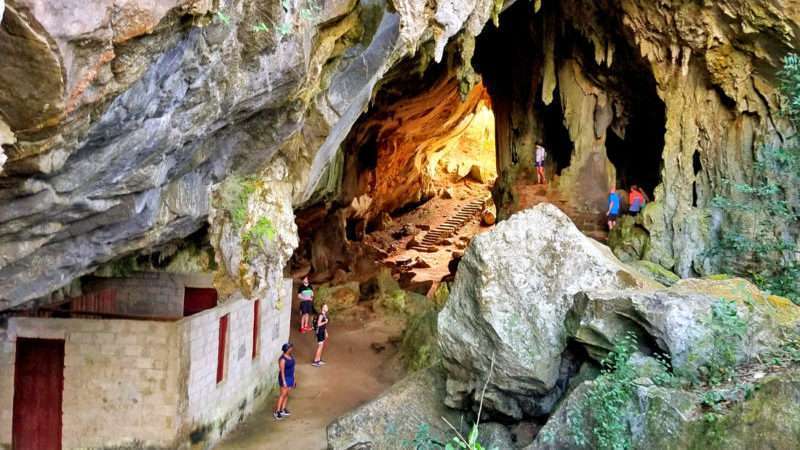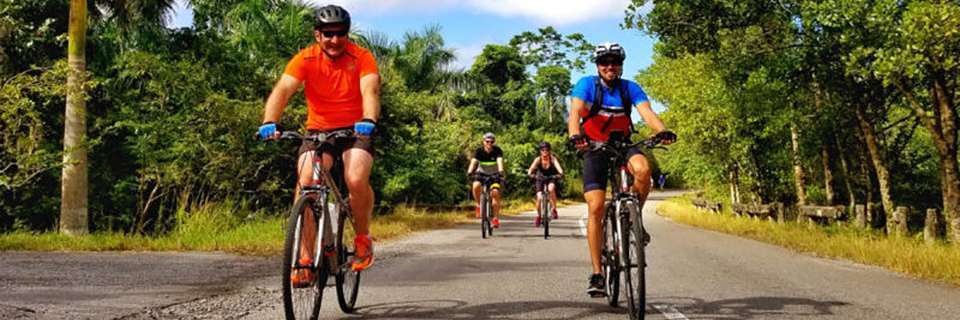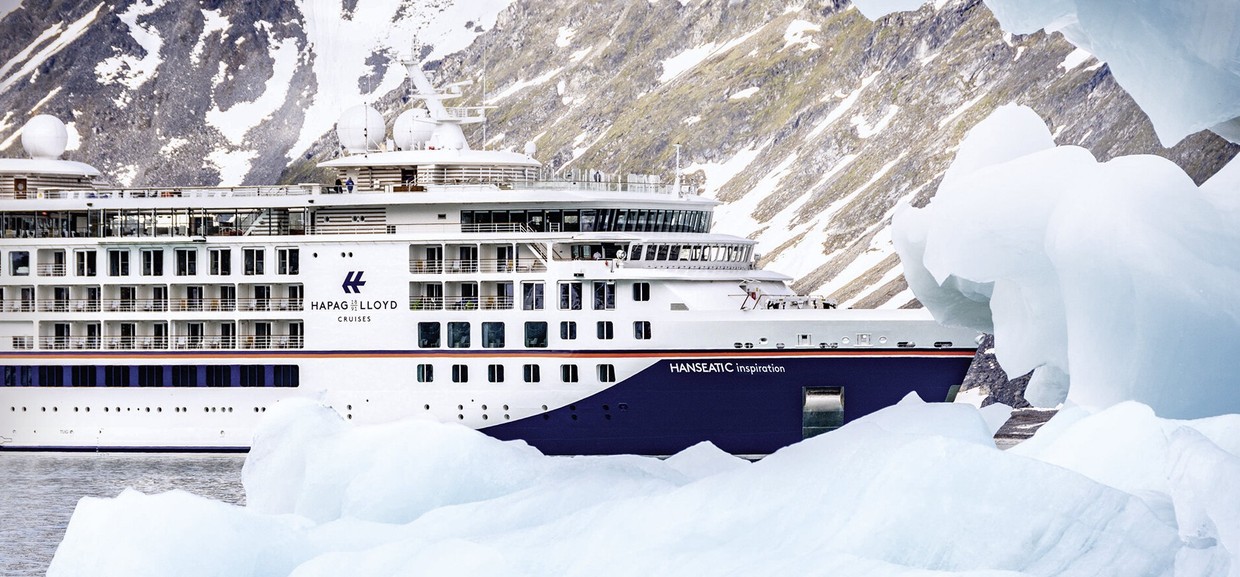Original blog post featured on The Journal by Intrepid Travel, by Frank Cheshire.
If you think the best way to see Cuba is from the backseat of ’52 Chevy, you could be right.
But an even better way to experience the Caribbean island is from the saddle of your trusty bike; wind in your (helmet-covered) hair, the smoky scent of tobacco on the breeze, and the promise of a knock-your-socks-off rum or two at the end of a long day of cycling.
I recently hit the (sometimes bumpy) road for a two-wheeled adventure across the country. Here are 11 things I learned in Cuba:
-
Cubans eat a *lot* – and the food is better than you think

Before my cycling adventure through Cuba, I’d heard so much about the food being bland, with good ingredients hard to come by. But that just wasn’t the case. Sure, we had the usual rice and beans with pretty much every meal (and a Mars bar was nowhere to be seen), but we also had stewed beef (ropa vieja), deep-fried yucca, pork, chicken, seafood and vegies. The Cubans are incredibly hospitable people and will always overfill your plate (or in the case of dinner, multiple plates). And despite riding almost every day, I still managed to put on weight (although that may have been the street pizza).
-
There are heaps of ups and downs

Cycling through Vinales
I’d never thought of Cuba as hilly, until I had to ride it. While the real hills are over in the east of the country (Pico Turquino is almost 2000m/6500ft high), the hills in the west are short but steep, and came as a surprise even to an experienced cyclist. Having said that, even the least fit person in our group refused to get off and walk up any of it – and the reward of a good climb (other than beautiful scenery and helping to burn off the oversized dinner from the night before) is the thrilling descent, with barely a turn of the pedals. Until you get to the next hill of course…
-
The roads are in pretty good condition (except when they’re not)

Soroa Road, Cuba
Cuba isn’t traditionally known for its good roads, but near the main towns the roads were as good as anywhere in more developed countries, and helped us keep a good riding pace. At one point I was even thinking I should have brought my road bike – until we turned a corner and left the main road. Suddenly it’s a different story, as the tarmac is replaced by gravel, potholes and patches of sandy soil that better resemble a beach than a road. It might sound terrible but it’s here that you experience the ‘real’ Cuba, as motorised vehicles are replaced by horse drawn carts. Thanks to the sometimes awful roads, a cyclist can get to places another vehicle simply can’t – which is the real beauty of cycling.
-
Cubans are considerate drivers

Our group (and a vintage car)
Growing up riding in the UK and Australia, I have a healthy respect – or perhaps fear – of motorists as they rush about their daily commute. It’s different in Cuba. Cubans don’t rush, or drive aggressively. In Cuba, the traffic seems to glide along with a mutual respect of all users of the road. Maybe it’s because those cars are too precious to scratch, or maybe it’s because a driver earns more than a doctor here, but either way, it’s bliss to cruise along with the traffic, without fearing for your life.
-
Don’t ignore the packing list

Garbage bag chic
It never rains in the Caribbean right, so why on earth would I need a raincoat? The simple answer to that is ‘because they usually look so much more stylish than wearing a garbage bag when you’re struck with torrential rain for three days’. But kudos to the local that saw the opportunity and sold us three ‘Cuban raincoats’ – and you know what, they worked a treat! Still, it’s better to be safe (and dry) than sorry (and dressed in a garbage bag) so make sure you’ve got everything on the packing list.
-
Life without regular internet is a blessing

Exploring the caves in Portales
In a data-obsessed world, even the simple act of cycling can be an excuse to get on to the internet. From uploading your rides to brag to your mates on Strava, to posing for Insta pics, to updating your travel blog, the pressure to post on the internet can be intense. In Cuba, that pressure isn’t there because in many places you just can’t get access to the web. Instead, focus on the humble act of riding your bike, just being in the moment and taking in your surrounds for what they are.
-
Cycling with people more or less experienced than you is an opportunity to learn and grow

Quick photo stop!
Truth is, I ride my bike every day, and as quickly as I possibly can most of the time. When I ride with others, they’re usually dressed in lycra and just obsessive as I am (and the numbers showing on my speedo are king). But cycling with people less experienced than I am was an epiphany. People that don’t race actually just enjoy riding: they enjoy the scenery, see things that would usually pass me by and, most importantly, they talk! About life, themselves, the country they’re visiting and how they’re feeling. They share the experience and help you see things from an entirely different perspective. So I thank my cycling companions for slowing me down and helping me smell the roses (or in Cuba’s case, the fragrant Mariposa flower).
-
It’s a perfect winter getaway – even in a Cuban winter

Cayo Jutias Lighthouse
Cuba has a reputation as a Caribbean paradise, but even paradise has a winter. The good news is that ‘winter’ in Cuba is a balmy 25C, so when it’s freezing in Europe and North America in December, January and February you can ride your bike to the closest gorgeous Cuban beach and enjoy the ‘winter’ sun.
-
If you want to impress the Cubans, get good at dominos!
Cubans love dominos. It’s a game that can be played on any street corner, or when the electricity isn’t working, or with a few shots of rum, and people of all ages partake in this most idiosyncratic Cuban pastime. At the end of a hard days’ cycling, settling down to a game of dominos as the light fades is a unique experience and a great way of interacting with locals (just don’t expect to win).
-
Cuba is full of surprises, yet somehow feels familiar

Cuban car park
Most people have a preconceived idea of Cuba, but what surprised me the most was how familiar the country felt. Cycling through Vinales, I was reminded of the limestone karst scenery of southern Thailand or Vietnam, and the decaying colonial buildings of Havana took me back to the streets of Yangon. But the one thing that made it all feel so familiar was the simple friendliness and generosity of the Cuban people. Relationships matter to Cubans, so you feel like an old friend each time you meet a local. And cycling seemed to amplify that feeling, judging by the waves and friendly holas we got when we rode through a village or small town.
-
T.S. Eliot’s famous quote “The journey, Not the destination matters” finally felt true

A perfect day in Soroa
Many times in travel, the journey can be tedious, or even onerous. Endless connections, time wasted, or bureaucracy seemingly getting in the way of a good time. Cycling in Cuba is predominantly about the journey, both physically and spiritually. On the bike, you really experience Cuba; you smell it, you feel it… Sometimes that feeling is a sore butt as you bounce along bad roads, or the smell of diesel fumes from a 1952 Cadillac, but the payoff is that you aren’t insulated from a single part of the Cuban experience. And isn’t that the true essence of travel?
Ready to don your helmet and cycle your way around Cuba? Jump on Intrepid’s 7-day Cycle Cuba tour now.
All images C/O Frank Cheshire






